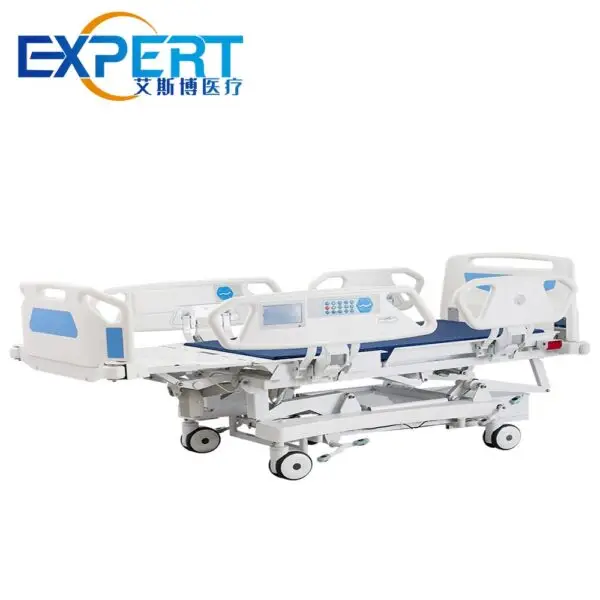Address
304 North Cardinal St.
Dorchester Center, MA 02124
Work Hours
Monday to Friday: 7AM - 7PM
Weekend: 10AM - 5PM

In emergency medical settings, the efficiency and versatility of mobile hospital beds play a crucial role in patient care. These beds are designed to be easily transportable within hospital premises, facilitating swift and effective patient management. This blog explores the advantages of using mobile hospital beds in emergency situations, emphasizing their impact on healthcare delivery and patient outcomes.









Mobile hospital beds are specifically engineered to enhance mobility within hospital environments. Equipped with sturdy wheels and ergonomic designs, these beds facilitate quick transportation of patients between different departments such as emergency rooms, operating theaters, and recovery units. This mobility minimizes delays in treatment and improves overall patient flow within the hospital.
Mobile hospital beds not only navigate corridors and elevators smoothly but also provide healthcare providers with the ability to swiftly transfer patients to critical care areas or diagnostic facilities as needed. This capability is particularly valuable during emergencies, where every second counts in delivering life-saving interventions.
One of the significant advantages of mobile hospital beds is their adaptability to various medical procedures and patient needs. These beds often feature adjustable heights, tilting mechanisms, and ergonomic support systems, ensuring optimal patient comfort and safety during procedures and recovery periods.
For instance, beds with electric controls allow healthcare providers to adjust positions seamlessly, facilitating procedures like intubation, wound care, and post-operative recovery. This flexibility not only enhances patient comfort but also supports healthcare providers in delivering precise and effective medical care.
In emergency settings where space is often limited and quickly evolving, mobile hospital beds offer a practical solution. Their compact design allows for efficient use of available space without compromising on patient comfort or medical functionality. Hospitals can maximize their floor space utilization by integrating these beds into flexible patient care areas, thereby optimizing the operational efficiency of healthcare facilities.
Furthermore, mobile hospital beds can be easily maneuvered into tight spaces such as examination rooms or temporary treatment areas, ensuring that critical care can be administered promptly without delays due to spatial constraints.
Modern mobile hospital beds are equipped with advanced technological features that further enhance their utility in emergency settings. These features may include integrated monitoring systems, electronic controls for bed adjustments, and connectivity options for seamless data transfer between medical devices. Such technological integration supports real-time monitoring of patient vital signs, improves communication among healthcare teams, and enhances overall clinical decision-making processes.
For example, beds equipped with telemetry systems enable continuous monitoring of patient parameters such as heart rate, blood pressure, and oxygen saturation levels. This real-time data allows healthcare providers to respond promptly to changes in patient condition, thereby improving outcomes and reducing the risk of complications.
| Feature | Description |
|---|---|
| Bed Frame Material | High-strength steel, aluminum alloy, or composite materials |
| Mattress Type | Foam, gel-infused memory foam, air mattress |
| Bed Dimensions | Length: 200-220 cm, Width: 80-100 cm, Height: Adjustable |
| Weight Capacity | Range: 180 kg to 350 kg depending on model |
| Mobility Features | Lockable caster wheels, central locking system, steering handles |
| Bed Adjustment Mechanisms | Electric, hydraulic, or manual controls |
| Safety Features | Side rails, brake systems, anti-slip surfaces |
| Additional Accessories | IV pole attachments, bedside tables, CPR functionality |
| Warranty and Service | Manufacturer warranty, optional service contracts |
| Environmental Considerations | Materials recyclability, energy-efficient designs |

To illustrate the practical benefits of mobile hospital beds, let’s consider a case study conducted in a large urban hospital. The introduction of mobile beds in their emergency department resulted in a 30% reduction in patient transfer times between departments, leading to faster intervention and improved patient outcomes.
The seamless integration of mobile hospital beds into existing workflows allowed for streamlined patient care pathways, minimizing bottlenecks and optimizing resource utilization. This case study highlights how investing in mobile hospital beds can yield tangible improvements in both clinical outcomes and operational efficiency within healthcare settings.
In conclusion, mobile hospital beds represent a pivotal advancement in emergency healthcare delivery, offering enhanced mobility, flexibility, and space efficiency. Their integration into hospital settings not only improves patient care outcomes but also supports operational efficiencies and clinical workflows. As healthcare institutions continue to prioritize patient-centered care and efficiency, the adoption of mobile hospital beds is poised to play an increasingly integral role in modern medical practice.
Q: Are mobile hospital beds as durable as traditional hospital beds?
A: Yes, mobile hospital beds are designed to meet rigorous durability standards and are capable of withstanding frequent use in demanding healthcare environments. They are engineered using robust materials and undergo stringent quality checks to ensure reliability and longevity.
Q: Can mobile hospital beds accommodate bariatric patients?
A: Many models of mobile hospital beds are specifically designed to support bariatric patients, offering enhanced weight capacity and reinforced structural integrity. Healthcare providers can choose from a range of bed options tailored to meet the needs of diverse patient populations.
